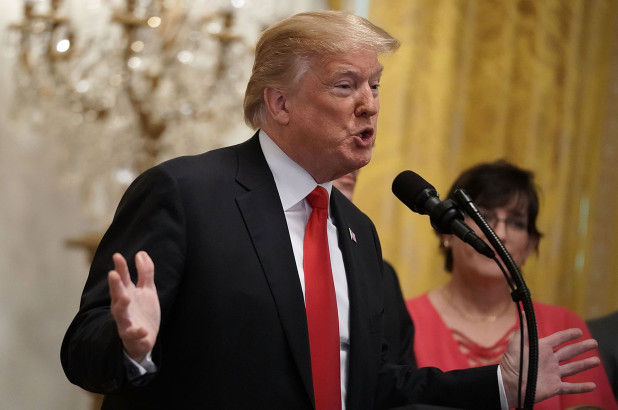The Trump administration released on Tuesday a list of 10 percent tariffs on $200 billion in Chinese goods, making good on the U.S. president’s recent threats to escalate a broadening trade war with Beijing.
“The $200 billion figure we’re looking at is roughly equal to their exports to us,” a senior administration official said.
The tariffs will not go into effect immediately but will undergo a two-month review process, with hearings Aug. 20-23.
Some of the products on the list facing tariffs are from Made in China 2025 sectors, the official said. Made in China 2025 is a strategic plan to make China a leader in key global industries, including technology.
When compiling the list of goods, the U.S. Trade Representative took into account what could cause disruptions to China’s economy.
The official said the administration has been extremely clear to China in terms of its concerns about trade, but China has been unresponsive.
“For over a year, the Trump Administration has patiently urged China to stop its unfair practices, open its market, and engage in true market competition,” U.S. Trade Representative Robert Lighthizer said in a statement.
“Rather than address our legitimate concerns, China has begun to retaliate against U.S. products,” he added.
The list of new sanctions follows warnings by Trump that he may implement tariffs on at least $500 billion in Chinese goods should Beijing retaliate against the $34 billion in U.S. tariffs that kicked in Friday.
Despite the president’s threats, China implemented retaliatory tariffs on the U.S. shortly after the $34 billion went into effect last week.
Trump has repeatedly threatened to escalate the trade conflict with China. The dispute with Beijing has roiled financial markets worldwide, including stocks, currencies and the global trade of commodities from soybeans to coal.
U.S. Trade Representative Robert Lighthizer released the following statement regarding the new tariffs:
“On Friday, in response to unfair Chinese practices, the United States began imposing tariffs of 25 percent on approximately $34 billion worth of Chinese imports. These tariffs will eventually cover up to $50 billion in Chinese imports as legal processes conclude. The products targeted by the tariffs are those that benefit from China’s industrial policy and forced technology transfer practices.
China has since retaliated against the United States by imposing tariffs on $34 billion in U.S. exports to China, and threatening tariffs on another $16 billion. It did this without any international legal basis or justification.
As a result of China’s retaliation and failure to change its practices, the President has ordered USTR to begin the process of imposing tariffs of 10 percent on an additional $200 billion of Chinese imports. This is an appropriate response under the authority of Section 301 to obtain the elimination of China’s harmful industrial policies. USTR will proceed with a transparent and comprehensive public notice and comment process prior to the imposition of final tariffs, as we have for previous tariffs.
On August 14, 2017, President Trump instructed USTR to begin the Section 301 process. For many years, China has pursued abusive trading practices with regard to intellectual property and innovation. USTR conducted a thorough investigation over an 8-month period, including public hearings and submissions. In a detailed 200-page report, USTR found that China has been engaging in industrial policy which has resulted in the transfer and theft of intellectual property and technology to the detriment of our economy and the future of our workers and businesses.
USTR’s Section 301 report found that Chinese policies and practices force U.S. innovators to hand over their technology and know-how as the price of doing business in China. China also uses non-economic means to obtain U.S. technology, such as using state-owned funds and companies to buy up American businesses and imposing burdensome intellectual property licensing requirements in China. USTR’s report also found that the Chinese government sponsors the outright theft of U.S. technology for commercial benefit. These practices are an existential threat to America’s most critical comparative advantage and the future of our economy: our intellectual property and technology.
For over a year, the Trump Administration has patiently urged China to stop its unfair practices, open its market, and engage in true market competition. We have been very clear and detailed regarding the specific changes China should undertake. Unfortunately, China has not changed its behavior – behavior that puts the future of the U.S. economy at risk. Rather than address our legitimate concerns, China has begun to retaliate against U.S. products. There is no justification for such action.
As in the past, the United States is willing to engage in efforts that could lead to a resolution of our concerns about China’s unfair trade practices and to China opening its market to U.S. goods and services. In the meantime, we will remain vigilant in defending the ability of our workers and businesses to compete on a fair and reciprocal basis.”
Source: CNBC
